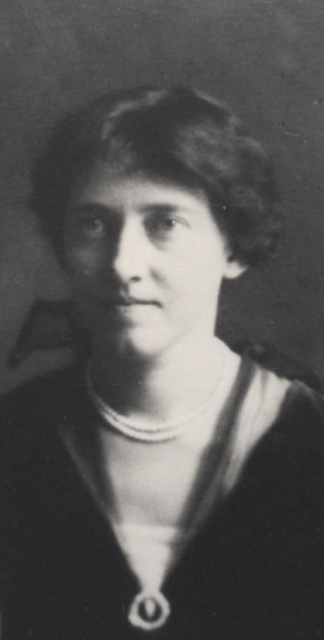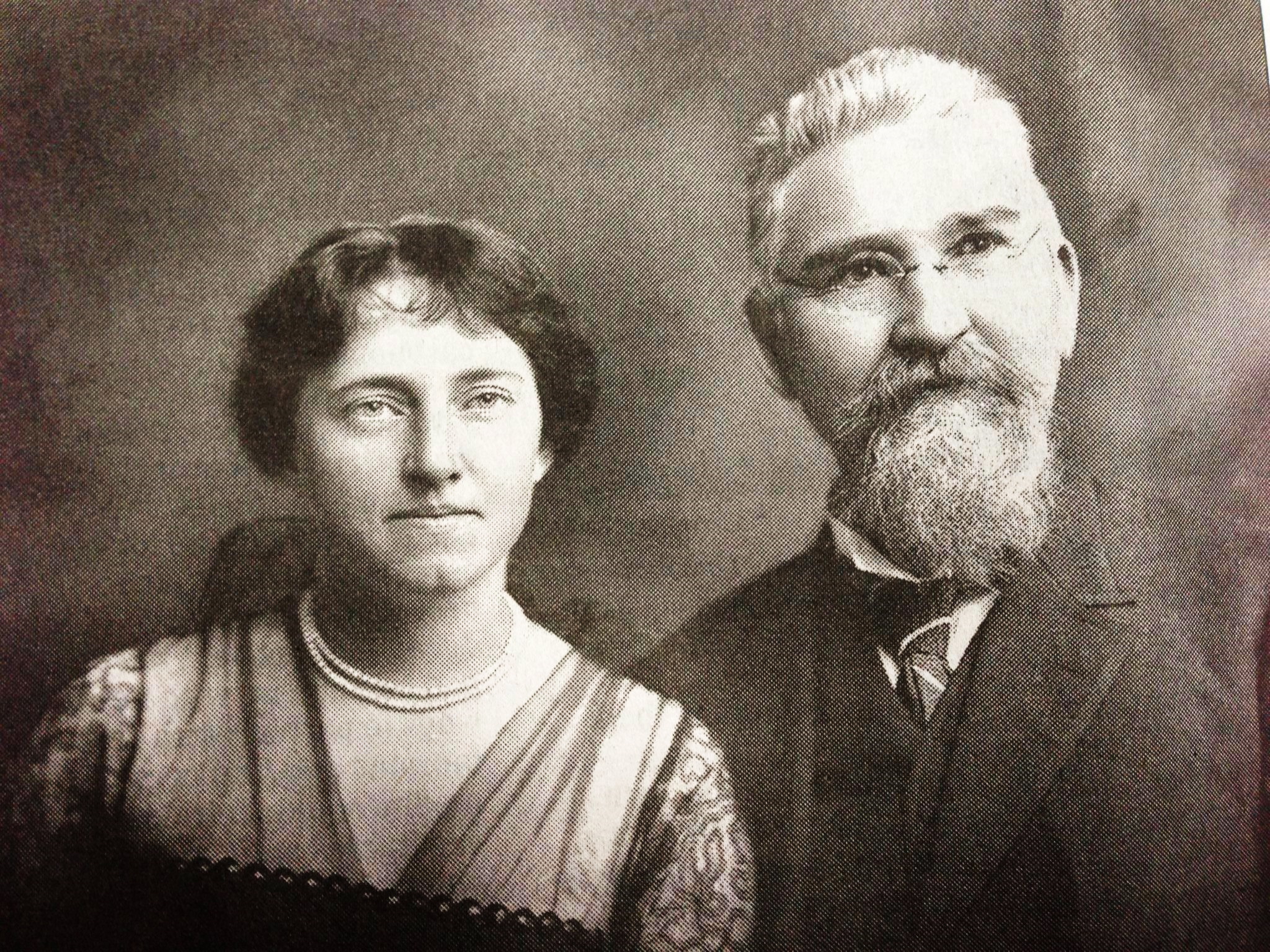Siblings: Joshua Franklin Smith, Maxie Henry Smith Dunn, Zachary Madison Smith, Eugene Gray Smith, Irene Hollingsworth Smith, and Ruth Gaines Smith Lucas
Spouse One: Richard Joshua Reynolds m. 2/27/1905
Children: Richard Joshua Reynolds, Jr., Mary Katharine Reynolds Babcock, Nancy Susan Reynolds Bagley Verney, and Zachary "Smith" Reynolds
Spouse Two: John "Edward" Johnston m. 6/11/1921
Children: Lola Katharine Johnston and John "Edward" Johnston, Jr.
Mary Katharine Smith was born to Zachary Taylor and Mary Susan Jackson Smith in Mount Airy, North Carolina, on November 17, 1880 and described by the Morning Post as "a young lady of rare accomplishments." Katharine was well educated and attended the State Normal and Industrial School, now known as the University of North Carolina at Greensboro, in the fall of 1897. After a typhoid epidemic broke out in 1899, Katharine transferred to Sullins College in Bristol, Virginia where she graduated in 1902. After returning home from graduation, Katharine worked for R. J. Reynolds, her first cousin once removed, as a secretary at The R. J. Reynolds Tobacco Company in Winston-Salem, North Carolina. Even though Katharine was 30 years R. J.'s junior, a romance blossomed between the two and on February 27, 1905, they were "quietly" wed in Mount Airy.
At the end of their European honeymoon, the couple returned to Winston and moved into a "beautiful home" (666 West Fifth Street) that was located a short distance from R. J.'s tobacco factories. Katharine did not remove herself from her husband's business but instead initiated progressive reforms in the factory that included the installation of water fountains, a provision of hot lunches and a nursery for working mothers. In addition, she became involved in numerous civic and social organizations that worked to improve the community and better the lives of others.
A year later, Katharine purchased land West of the city in order to build a country estate designed for healthy living. "In most cases," said Michele Gillespie in her dual biography of the couple, Katharine and R. J. Reynolds: Partners of Fortune in the Making of the New South, "the land was registered in [Katharine's] own name alone, a rare legal act for married women in this period."
Between 1906 and 1911, Katharine and R. J. saw the birth of four children: Richard Joshua Junior, Mary, Nancy and Zachary Smith. Despite her new responsibilities, Katharine continued to purchase land and focus on the estate. In 1912, her dream was realized when construction began on "Reynolda."
At its completion, the estate totaled more than a thousand acres. The "large-scale" bungalow featured a host of modern conveniences that included a central vacuuming system and air conditioning. Because hygiene was of utmost importance, the kitchen was designed with stainless steel counters and each bedroom had a bathroom—some bedrooms also had an adjacent sleeping porch. And, to ensure music could be heard throughout the house, Katharine had an Aeolian pipe organ installed. The grounds of the estate—which promoted recreation and exercise—consisted of formal gardens, meadows, woods, an outdoor swimming pool and an 18-acre lake.
The Reynolds family did not move to the estate until December 1917, yet it was already alive with the activities of farmers and their families. In addition to the house, Katharine created a model farm where "progressive agricultural methods" could be learned. On the self-sufficient estate, disease-free milk was produced, livestock was raised and produce was grown. For her employees, Katharine created a community of schools, churches, recreational facilities and a post office. As noted by Gillespie, "The completed estate was a marvel."
Seven months later, however, on July 29, 1918, sadness entered the house when pancreatic cancer took the life of Winston's tobacco tycoon. Following R. J.'s death, Katharine continued to manage the estate and support philanthropic programs. In 1921, she and J. Edward Johnston—the former superintendent of Reynolda School—were married in a "secretive ceremony" at Reynolda. And, like she and R. J. before, the two traveled to Europe for their honeymoon. In 1924, Katharine gave birth to J. Edward Johnston Junior, but she would not live to see him grow. Three days after the delivery, on May 23, 1924, Katharine died as the result of an embolism.
Although her time at Reynolda was short, Katharine's legacy has endured. Reynolda House Museum of American Art opened "to the public as an institution dedicated to the arts and education in 1965, and as an art museum in 1967." Today, visitors can tour the restored Reynolds family estate, walk the landscaped grounds and enjoy the gardens. At Reynolda Village, tourists can explore buildings that "once supported the estate" but now house shops and restaurants. Thanks to the vision of Katharine Smith Reynolds, there is a place of unequaled beauty in Winston-Salem where "all are welcomed."
https://reynolda.org
Siblings: Joshua Franklin Smith, Maxie Henry Smith Dunn, Zachary Madison Smith, Eugene Gray Smith, Irene Hollingsworth Smith, and Ruth Gaines Smith Lucas
Spouse One: Richard Joshua Reynolds m. 2/27/1905
Children: Richard Joshua Reynolds, Jr., Mary Katharine Reynolds Babcock, Nancy Susan Reynolds Bagley Verney, and Zachary "Smith" Reynolds
Spouse Two: John "Edward" Johnston m. 6/11/1921
Children: Lola Katharine Johnston and John "Edward" Johnston, Jr.
Mary Katharine Smith was born to Zachary Taylor and Mary Susan Jackson Smith in Mount Airy, North Carolina, on November 17, 1880 and described by the Morning Post as "a young lady of rare accomplishments." Katharine was well educated and attended the State Normal and Industrial School, now known as the University of North Carolina at Greensboro, in the fall of 1897. After a typhoid epidemic broke out in 1899, Katharine transferred to Sullins College in Bristol, Virginia where she graduated in 1902. After returning home from graduation, Katharine worked for R. J. Reynolds, her first cousin once removed, as a secretary at The R. J. Reynolds Tobacco Company in Winston-Salem, North Carolina. Even though Katharine was 30 years R. J.'s junior, a romance blossomed between the two and on February 27, 1905, they were "quietly" wed in Mount Airy.
At the end of their European honeymoon, the couple returned to Winston and moved into a "beautiful home" (666 West Fifth Street) that was located a short distance from R. J.'s tobacco factories. Katharine did not remove herself from her husband's business but instead initiated progressive reforms in the factory that included the installation of water fountains, a provision of hot lunches and a nursery for working mothers. In addition, she became involved in numerous civic and social organizations that worked to improve the community and better the lives of others.
A year later, Katharine purchased land West of the city in order to build a country estate designed for healthy living. "In most cases," said Michele Gillespie in her dual biography of the couple, Katharine and R. J. Reynolds: Partners of Fortune in the Making of the New South, "the land was registered in [Katharine's] own name alone, a rare legal act for married women in this period."
Between 1906 and 1911, Katharine and R. J. saw the birth of four children: Richard Joshua Junior, Mary, Nancy and Zachary Smith. Despite her new responsibilities, Katharine continued to purchase land and focus on the estate. In 1912, her dream was realized when construction began on "Reynolda."
At its completion, the estate totaled more than a thousand acres. The "large-scale" bungalow featured a host of modern conveniences that included a central vacuuming system and air conditioning. Because hygiene was of utmost importance, the kitchen was designed with stainless steel counters and each bedroom had a bathroom—some bedrooms also had an adjacent sleeping porch. And, to ensure music could be heard throughout the house, Katharine had an Aeolian pipe organ installed. The grounds of the estate—which promoted recreation and exercise—consisted of formal gardens, meadows, woods, an outdoor swimming pool and an 18-acre lake.
The Reynolds family did not move to the estate until December 1917, yet it was already alive with the activities of farmers and their families. In addition to the house, Katharine created a model farm where "progressive agricultural methods" could be learned. On the self-sufficient estate, disease-free milk was produced, livestock was raised and produce was grown. For her employees, Katharine created a community of schools, churches, recreational facilities and a post office. As noted by Gillespie, "The completed estate was a marvel."
Seven months later, however, on July 29, 1918, sadness entered the house when pancreatic cancer took the life of Winston's tobacco tycoon. Following R. J.'s death, Katharine continued to manage the estate and support philanthropic programs. In 1921, she and J. Edward Johnston—the former superintendent of Reynolda School—were married in a "secretive ceremony" at Reynolda. And, like she and R. J. before, the two traveled to Europe for their honeymoon. In 1924, Katharine gave birth to J. Edward Johnston Junior, but she would not live to see him grow. Three days after the delivery, on May 23, 1924, Katharine died as the result of an embolism.
Although her time at Reynolda was short, Katharine's legacy has endured. Reynolda House Museum of American Art opened "to the public as an institution dedicated to the arts and education in 1965, and as an art museum in 1967." Today, visitors can tour the restored Reynolds family estate, walk the landscaped grounds and enjoy the gardens. At Reynolda Village, tourists can explore buildings that "once supported the estate" but now house shops and restaurants. Thanks to the vision of Katharine Smith Reynolds, there is a place of unequaled beauty in Winston-Salem where "all are welcomed."
https://reynolda.org
Inscription
KATHARINE · SMITH · JOHNSTON
NOVEMBER · THE · SEVENTEENTH · EIGHTEEN
HVNDRED · AND · EIGHTY · MAY · THE · TWENTY
THIRD · NINETEEN · HVNDRED · AND · TWENTY · FOVR
Family Members
Sponsored by Ancestry
Advertisement
See more Reynolds Johnston or Smith memorials in:
- Salem Cemetery Reynolds Johnston or Smith
- Winston-Salem Reynolds Johnston or Smith
- Forsyth County Reynolds Johnston or Smith
- North Carolina Reynolds Johnston or Smith
- USA Reynolds Johnston or Smith
- Find a Grave Reynolds Johnston or Smith
Records on Ancestry
Sponsored by Ancestry
Advertisement



































